With all of the sub-roadbed completed it is time to get busy with the next layer up – roadbed. For the mainlines I am using Midwest HO Cork Roadbed. It is 3/16″ thick by 1-3/4″ wide. Spurs and yards will be done in flat 1/8″ sheet cork.
I picked up a tidbit of useful advice on a woodworker forum. They advised the use of black graphite paper for tracing the track plan instead of the more common carbon paper. According to the woodworkers, carbon paper can sometimes leave behind a waxy oily film that interferes with getting a good glue bond. To add to this, graphite paper makes a much darker and sharper line they said. Having acquired graphite paper and given it a whirl I can positively say it was good advice. The graphite paper is much less messy to work with (no funk on your hands) and most definitely produces a bold mark even under light tracing pressure. If you are going to trace your own track plan it is well worth your time to seek out graphite paper. The local Michaels store had 18″ x 24″ sheets in their scrapbooking department although oddly enough I can’t find it on their web site.
A piece of the graphite transfer paper was slid under the track plan and the track centerline traced onto the plywood. Next, a thin bead of wood glue is laid down one side of the centerline mark. The cork roadbed comes sliced down the middle so you simply separate each piece into two halves and then lay the cork lining it up with the traced centerline. Pushpins hold it in place until the wood glue dries.
After pressing in a couple dozen pushpins I felt there must be a better way. Pushing the pins into hardwood plywood is no easy task and fingers get sore. So, I made a little pushpin installation tool. It has a bore to hold the pushpin straight up and down and a pair of hardboard edges that keep me from over-driving the pin into the cork. The large flat area of the wood handle makes it easy to press pins without getting sore fingers. Ah, much better.
No rocket science going on here, just a lot of repetition. Trace, glue bead, lay cork, pin. Rinse, repeat.
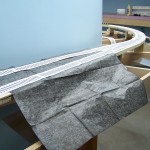
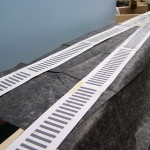
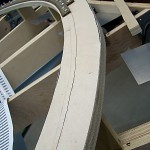
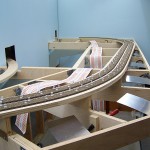
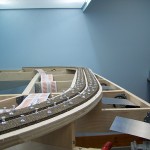
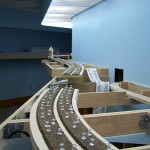
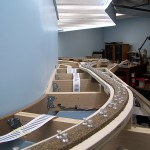
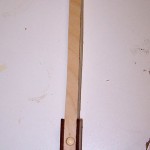

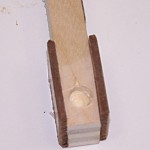
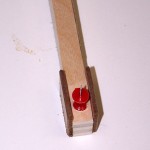

Picture #3, the first with cork in place, has the cork off center to the roadbed. It doesn’t look wide enough to be double track so what is the purpose for the placement as such? I like the pin tool. Ingenuity every step of the way building a pike for sure.
What did you use to draw along the center line of the paper copy to make the transference? Just thinking that something along the lines of a narrow roller that is used to insert the rubber retaining “noodle” into the channel for nylon screen windows would be quick and easy. The one I have has two wheels, 1/16″ and 3/32″ width. Just a thought.
Jeff
Jeff, The off center is a result of the grade. The sub-roadbed was cut with the track plan laying flat. Once the sub-roadbed was positioned on a grade the track plan became slightly offset in the large curve to compensate. Knowing that variations such as this would occur is why the sub-roadbed is 3″ wide while the cork is only 1-3/4″.
Plain #2 pencil. It went very fast. Not important the line be perfect. It can have little wiggles in it. The natural movement of the cork smooths out the line. In fact, a mark every couple of inches would probably work just as well.
Nice work Alan, I feel like I am watching a time delay photo sequence. Think back to seeds sprouting and becoming plants over a season. In this case it is an idea becoming a track plan and then a model railroad.